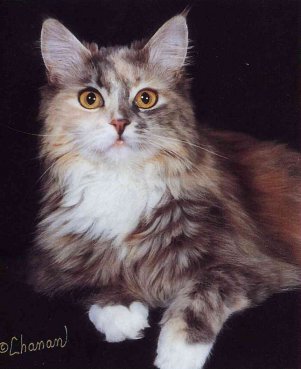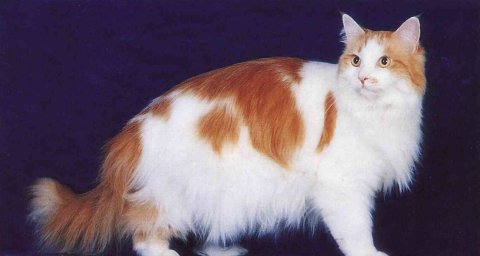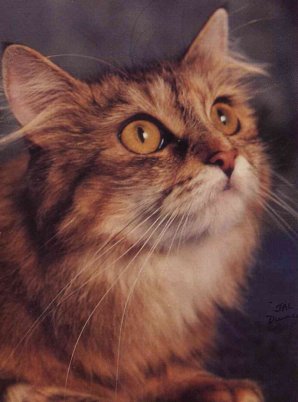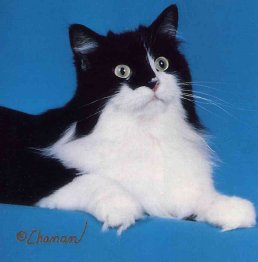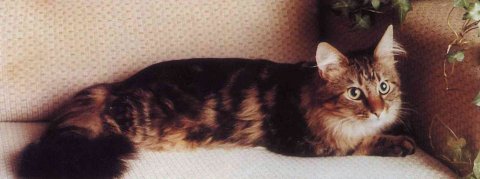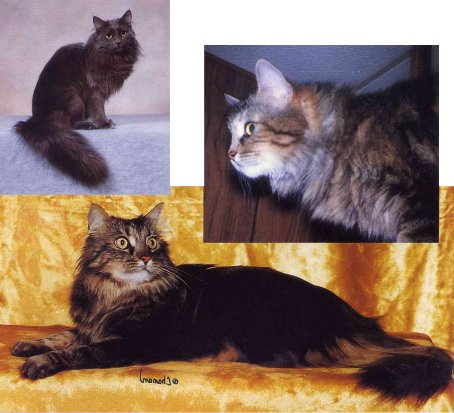| "This page was originally a part of the Maine Coon Heritage Site, a site that was first created in 1998 by Cynthia Bowen (Coontopia), Ulrika Olsson (Ylletrollets), Astrid Straver (Tricks and Tails) and Janet Marr (Furkats). It was then taken over by PawPeds, and it is now split up to fit better with the structure of PawPeds' website." |
 |
Roselu Cattery
Tucson, Arizona 1977-87
By Helen Louise Wohlfort as told to Beverly Caldwell
|
Kayenta La Paloma of Roselu |
During the lazy days before world war II, I was a little kid in a tiny town in Southern Arizona. A family from a state called Maine moved to town, and their family pet was the biggest cat I'd ever seen. They called him a skog cat. The daughter in the family was my age, and we soon became good friends. Some of my fondest memories of our playtime together are of her and land that big brown tabby. As I recall these memories, I know that from the first day I met him, I wanted a cat like that for my very own.
Thirty-five years passed, and I forgot all about skog cats and a state called Maine. Sometime during 1975, I read a breed article in Cats Magazine about Maine Coon Cats, and I was stunned to see photos of that skog cat of long ago! Of course, it wasn't him, but that old love gently welled-up in my heart. Later, I went to a cat show in Tucson and met the first registered Maine Coon Cat I'd ever seen. He was Zig-Krn My Boy (I can't recall his actual official name - he may have been Morace's My Boy of Zig-Krn). He was unattended; I knew not to touch him, but I couldn't help but talk to him! We'd had a great conversation for a while when Karen Kozaczka came up and said, "He won't talk to you." I said, "But we've been talking for 10 minutes!" Karen was amazed as he never would talk to strangers!
In early 1976, I joined a local cat club and became an active participant in the cat fancy. In July, I went to my first cat show as an exhibitor with my household pet - a large black and white spar named Diablo aka Dab. She was nine years old, had never been shown before, and quickly decided it was not for her. She was very cranky and very unhappy and that was her first and last show.
The beginning of the Roselu Cattery
By now, I was hooked on the Maine Coon Cats, and I really wanted one for my own. I wrote letters to breeders who had ads in Cats Magazine and was surprised when most did not answer; I learned that they were accustomed to selling kittens by telephone. Helen Andre (Illya) was one of the few who did answer. She sent photos of cats she had available; I picked Illya's Yankee Patriot who was only 3 months old when he arrived in Tucson by Air Freight in October, 1977. (He was young due to weather considerations: she had to ship before it was too cold in Connecticut to send him.) I had planned to neuter him and show him as an alter, but the thought of breeding was in the back of my mind, and I discussed it with Helen. She had no objections and I soon changed my mind about neutering. He was the beginning of Roselu cattery. My first female was Felton's Feather of Zig-Krn (of Roselu in CFA).
The name Roselu came from my love of roses, my middle name (Louise), and a sale's gimmick - a free "vanity" license plate for my new car. I wanted 'Roselou', but only 6 letters were allowed so I left out the "o". This was several years before Roselu Cattery, but it just seemed a natural when I needed a cattery name. Then, it seemed only natural to name my cats for roses! I kept handy a book published by the American Rose Society that contained the name of every registered rose. Roselu cats' names have included Peace, Garden Party, Lady Godiva, Rococo, my two MCs who still live with me are Passport and Finale, both from rose names.
|
Roselu Passport, DOB 17 September 1984 |
My Yankee would not be very good by today's Maine Coon standard, but he wasn't too bad in his day. He was of CFF type with a shorter head and body than we'd want today, but he had gorgeous eyes and good ears. He also had a nice nose dip which is a trait sometimes lost with today's longer heads. He weighed about 12 Ibs. at his prime and sired only one litter which included La Paloma's father, Roselu Blue Star. Yank developed cystitis at 15 months and a perineal urethrostomy was performed to save his life. Before he retired he had granded in UCF, ACA, ACFA, TICA and CFA. His kidneys failed at age 12, and I had to put him down.
Over the years I out-crossed my cats mostly to Charmalot and later Morace. Although never huge, my cats were always very healthy. I firmly believe that breeding to excessive size contributes to hip dysplasia. Like other breeders, I've developed y my own idea of what I like in a Maine and it's not always in agreement with others. I still prefer the older style cats. The old standard said a Maine should look like it has a little box at the end of the muzzle, and I agree. I do like the longer bodies but not the "basketball" heads or the "alligator" looking muzzle. I like them somewhere in between with a firm and perpendicular muzzle. I prefer a Maine with his ruff on the chest and shoulder rather than all around his face. I also don't like the fat whisker pads which some folks call "feral". Actually, I think "feral" is a misnomer. I've seen many feral studs with huge stud jowls, but I've never seen one with fat whisker pads.
Painted ladies
|
Roselu Garden Party. |
As far as colour, I tired of all brown tabby litters and specialised in bicolors and "painted ladies". High whites are my favourite in the tabbies today, but the bicolors are my real love closely followed by the Almond Joys (toms) (Editor's note: Almond Joy = Cameo) and calicos. I prefer the personalities of the bicolors as they are sweet all of the time. (I know there is disagreement as to whether or not personality traits are linked with colour if a bicolor, tortie or calico is to do well on the show bench, however, it must be big. In the past, judges in general seemed to be predisposed to finalling the brown or the brown w/white tabbies, but other colours seem to be finalling more often lately - the blacks, reds, and silvers. I would like to see more judges judge by the cat and not by the pound.
I feel strongly that breeders should breed to meet the standard rather than changing the standard to fit the cats they breed which has resulted in the different looks we see today. The Maine Coon Cat is enjoying a period of popularity now, but if we want to continue over the years we must decide which look we want and everyone must breed for it. (Yes, I know - the magic needed to get breeders to agree is lost under Merlin's hat) Breeders should have a picture in mind of the ideal and breed to that, regardless of colour. As the old saying goes, "Build the barn before you try to paint it." Also, the standard does not say the MC should be a huge cat. It says "medium" in most associations although I believe TICA has changed the wording to "medium to large". In my book that still doesn't mean 20 lb. cats that are prone to health problems because of size. The emphasis on size only without regard to type and balance is reprehensible to me.
|
Roselu Finale, |
Some of the catteries with whom I worked closely were Charmalot, Kiskata, Friscoon, Morace, and Heidi Ho. The old Illya and Zig-Krn (Morace) lines were critical to my initial success. My best kittens came from outside lines such as Friscoon, Charmalot, Kerry Kits, and Kiskata. The best of all the cats I bred were from Charmalot Strawberry of Roselu. Her picture can be seen in the book, "This is the Maine Coon Cat", by Sharyn Bass, page 56. In the middle of this book is the photo of a 'Berry grandson, Roselu Rococo AKA Rocky. Some of my CFA Grands include: Illya's Yankee Patriot of Roselu, Roselu Blue Star, Roselu Apache Bell, Roselu Passport, Roselu Hi Ho (Ruffles), Kayenta La Paloma of Roselu. La Paloma was All-American Calico in 1980; Passport was 17th. Best Inter American ACFA alter in 1989; Blue Star took a regional Best of Breed.
In 1985, Roselu sent some of the first breeding Maine Coon Cats to England at the request of Anita Rowsell of Pusiluv cattery near Lewes, Sussex. (Kiskata, Solkatz, and Mary B also sent kittens.) She chose a queen from Roselu, Kayanta La Paloma of Roselu, a blue cream/white who had been bred by Roselu Pharaoh, a red tabby w/white, a son of Charmalot Strawberry of Roselu and a H.H. Sonkey Bill son but not a clone. La Paloma delivered the first Maine Coon litter in England. Kittens Roselu Rendez-vous (cream tabby/white male) and Roselu Patience (calico), a granddaughter of Friscoon's Buffalo BilI, were also sent. Today, there is no trace of Patience except for her appearance on a small number of pedigrees; Rendez-vous is neutered and lives a happy, spoiled life in Sweden. La Paloma, born just before Lady Diana's wedding to Prince Charles, was put to sleep the very same day as Princess Diana's funeral.
Regain Hybrid vigour by out-crossing
|
Solkats Luciano P |
Using unpedigreed foundation cats is a frequent topic today. When CFA closed the registration, I was in favour of it, but today I realise that we really did not have a large enough gene pool. There should be a provision for foundation cats; however, they should not be shown even altered until at least the 3rd generation. As to line-breeding, I'd say yes, but the secret is 'very carefully!' One should not line-breed more than three or four generations but then outcross to regain hybrid vigour, i.e. size and good health. Constant out-crossing will result in cats that may or may not have a good temperament or type. The happy medium is best. Line breed to set "your look" then outcross occasionally to maintain health and vigour.
As far as advice for 'newbies' I'd say study genetics and breeding thoroughly, and don't even consider breeding cats until you've shown an alter at least one full show season - and never show a cat who hates to be shown. Learn all about showing, putting on shows, the paperwork involved, the politics, etc. Also, learn to clerk for you learn things you'd never learn by just watching - you see all the cats in the show and observe which cats go up; judges will often give you some insight as to why they put one up and not another. Also, before you buy the first breeder, preferably a female, decide on a budget. This is critical because cat breeding is an expensive hobby - don't expect to make a profit! When I started, I never dreamed of shipping a cat out of state for breeding; now, this is often the best way to improve your cattery.
Start with good 'raw material'
|
Left top corner: Roselu Blue Star |
I firmly believe you should buy the pedigree, not the cat. The individual may not be show quality, but the pedigree should include many good or outstanding cats. Don't breed to a cat with ancestors who had many faults and always breed to the very best male you can find. If a queen has faults, but a good pedigree, the stud may compensate for her faults. Don't try to economise on your stud; he'll be the mainstay of your cattery so buy the very best you can afford. Don't try to buy cheap and breed up - it ends up being more expensive than buying a good cat to begin with. Anyway, I don't believe you can "breed up" - you must start with good 'raw material'. If you see a great cat at a show, don't look for one of his kittens but rather see if you can get a stud service from his father! And handle kittens from birth - they are more likely to love people when they grow up.
I retired from breeding cats when I had 20 cats at home and realized that with the life span of a MC, if I needed to take back any cat of my breeding, I'd be taking on more cats well into my 70s! You see, I feel that responsible breeding demands that the breeder is willing and able to take back any cat she's bred if it becomes necessary. In addition, I feel it is irresponsible to breed cats that will outlive you. I'm thankful to know that I do not need to worry about the fate of any kitten I've bred. Today, two "oldsters" of my own breeding keep me company - Passport (14 years old as is litter mates Roselu Hi Ho (Ruffles) and Roselu Rendez-vous and Finale (11-1/2), my very last kitten, who came back at 5 years of age. I no longer have show MCs but enjoy showing HHPs and other breeds as well. I am still a resident of Southern Arizona, an older kid now in a much bigger town, still in love with Maine Coon Cats and the memory of that one special skog cat of long, long ago.
© "Maine Coon International", issue 16, 1998.
Reprinted with permission.
Editor’s note: As to what happened to "Roselu Patience" (who is mentioned above), we received an email from one of her last owners: "In the article, there's a reference to Roselu Patience and that there was no record of what happened to her. Well, I can fill in a small part of the story. Back in the mid 1980's, my wife and I were living in England and were interested in buying a Maine Coon. At that time, Anita at the Koonluv cattery had made the decision that Patience was not going to have another litter and she agreed to sell her to us so long as we agreed not to breed her. I'm afraid that I lost track of what happened to Patience after my wife and I separated but back in 1990, she was still a beautiful cat with a wonderful temperament...". Nick Edwards, September 2008.

